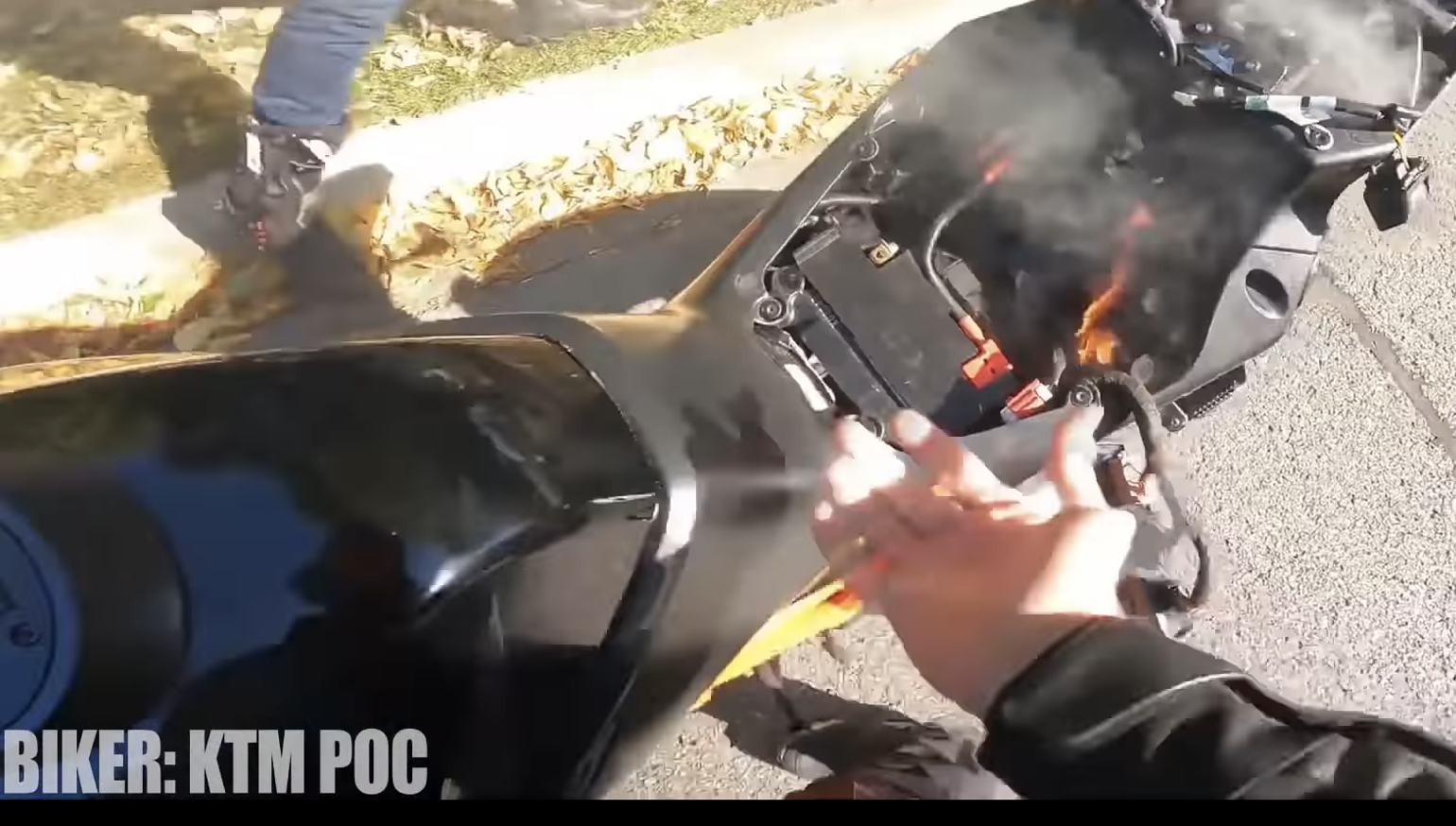Sometimes I’ll give in to YouTube’s relentless promotion of clickbait videos and watch a moto fails compilation. We’ve all been drawn by their siren song at one time or another, right?
I watched through a Moto Stars video titled “Burning Bike Drives Away By Itself” because that’s a pretty catchy title. I find it’s best to keep your expectations low so that you might be pleasantly surprised with these compilations. However, this video is a nice example of a runaway starter condition, so let’s take a look at what happened, and how these two riders could have controlled the situation. Relevant clip starts at 4:22.
Our two riders are cruising around town when something goes wrong with the KTM 1290 Super Duke. They pull over to investigate as smoke starts curling out from under the seat. The Super Duke's rider holds the clutch in and expresses confusion as the bike’s starter spins uncontrollably, even when they hit the kill switch or turn the bike off. The riders remove the seat and try to pull wires to disconnect the battery, but it doesn’t work, so they try throwing dirt on the burning wires to put out the fire. The bike’s starter spins again while they’re getting more dirt and the riderless bike jumps forward into traffic, though it falls on its side before it can hit a car. They pull the bike back upright and poke at stuff until someone comes along to loan them some tools. The comments seem to suggest that the bike wasn't salvageable.
I've seen this same issue happen to several bikes over the years, from Harleys to Chinese scooters, and it can be a pretty alarming experience. Here are three big things I'd do when faced with a runaway starter.
1. Don’t leave an intermittently starting bike in gear.
At the first sign of trouble with the Super Duke, the rider pulled in the clutch and held it until the bike stopped running or trying to start itself. Nice thinking, but the rider released the clutch and left the bike in gear to start investigating the smoke under the seat. Here's the problem: When the clutch was released, the rider unknowingly set the bike up to push itself off its side stand as soon as the malfunctioning relay spun the starter again, and that's exactly what happens shortly afterwards. Thankfully, the bike didn't get far.
If you’re ever in a situation where a motorcycle is uncontrollably starting, get the transmission in neutral, then start looking for a way to kill the power.
2. Keep some basic tools on your person or with your bike.
Not so long ago, most motorcycles came with onboard tool kits. You might get a factory tool kit today (KTM’s happen to be among the best available), but tool kit storage areas are less common and arguably less necessary than they were in the past. Still, it’s a good idea to have basics, like insulated pliers, screwdrivers, hex keys, and a socket set, or even a small multitool like a Leatherman. Heck, a keychain Swiss Army knife would've done the trick for this Super Duke.
Tools could have removed those battery terminal screws and disconnected the battery leads as soon as they pulled the seat off, which would a) skip throwing handfuls of soil into the bike, b) prevent the wiring harness from burning up any further, and c) avoid the starter-induced tipover that happens when they leave the bike in gear. You’ll hear one rider begging for pliers as soon as someone comes out to help at the end. Tools are your friends!

3. Don’t forget about fuses, your first line of electrical defense.
You don’t need an electrical engineering degree to ride a motorcycle, and we should all be glad for that. Even so, some basic knowledge of motorcycle electrics could have saved the day for these two riders.
The Super Duke’s uncontrollable cranking tells us that power is going to the starter motor when it shouldn’t be, and the riders quickly discovered that they couldn’t disrupt or control that cranking with the bike’s switches. If this happens to you, and you left your tools at home, don’t panic! Instead, access your fuses. Most modern bikes, including this Super Duke, have a fuse box, plus an additional fuse on the starter relay itself. That starter fuse is clearly visible and accessible in this video. (Two bright green blade fuses can be seen when the seat's popped off. One is the actual fuse, and the other is a spare on this particular bike.) Pulling the starter fuse will break the circuit and stop the starter motor right away, minimizing damage and defusing a dangerous situation without tools. Now the bike can be safely transported to a shop or your garage for diagnosis and repair.
I’ve personally had this exact scenario happen to me on a dirt bike. I did have tools with me, thankfully, to pull the bodywork off and yank the starter fuse in time. Whew! Keep some basic tools with you, use neutral to prevent a malfunctioning bike from crashing itself, and familiarize yourself with your motorcycle’s fuses just in case. Quick action could be the difference between a new wiring harness and a new bike!








